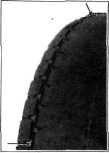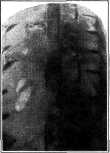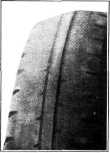1942 - 1947 CHEVROLET SHOP MANUAL
Section 10 - Wheels & Tires
|
|
|||||
|
10-2
|
|||||
|
|
|||||
|
produces more even
wear, while on the front tires, the braking stress is the only one
effective. An example of heel and toe wear is shown in Fig. 1.
SIDE OF CAMBER WEAR
There are several
reasons why tires wear more rapidly on one side of the tread than on
the other: 1. Wheel camber causes the tires to run at a certain angle
from the
|
only a normal amount
of deflection or bulge at the
point of contact with the road.
TOE-IN OR TOE-OUT
MISALIGNMENT WEAR
When there is
excessive toe-in or toe-out, tires will revolve with a side motion and
scrape the
|
||||
 |
tread rubber off. If
the misalignment is severe the rubber on both tires will be scraped
off, but if the misalignment is slight or is caused by a bent steering
arm, the rubber on only one tire will be scuffed off.
The scraping action
against the face of the tire
causes a small feather edge of rubber to appear on one side of
|
||||
 |
perpendicular,
resulting in side wear. Fig 2 shows an example of side wear caused
by excessive camber. This condition may be corrected by correcting
the camber and interchanging the
tires.
2. High
crown or high cambered
roads cause an increased
|
||||
|
the tread design. This
feather edge is the evidence of irregularity as
|
|||||
|
Fig. 4-Tire Wear Due
to Improper Toe-In or Toe-Out
|
|||||
|
Fig. 2-Tire Wear Due
to Improper Comber
|
wear on the side of the right
front tire.
|
||||
|
shown by the arrows in Fig. 4.
UNEVEN TIRE WEAR
Other types of uneven
tire tread wear are due to some irregularities, such as uneven caster,
bent
axles, wobbly wheels,
|
|||||
|
3. Side
thrust when
rounding turns causes
wear on the sides of the treads. In making a turn to the left,
especially at high speeds, the outside shoulder of the right tire and
the inside shoulder of the left tire take most of the wear. When
making a right-hand turn, the opposite shoulders of the tires are
worn.
4. Excessively low
inflation will also cause undue wear on the sides of the tires. Under
no circumstances should the
|
|||||
 |
out-of-round
brake drums, unequally
adjusted brakes, or other mechanical difficulties. Fig. 5, and can be
corrected only by correcting the conditions which
are causing it. Too much
toe-in or toe-out combined with under-inflation will also cause uneven
tire wear.
Truck tires follow
|
||||
 |
pressure be allowed to
drop below the minimum pressure recommended for the particular car
and size of tire. In general, tires should be inflated a few pounds
above the minimum pressure recommended.
See "Inflation Pressure."
An example of
two-sided wear is shown in
|
||||
|
very much the same
|
|||||
|
Fig. 5-Wear Due to
Mechanical Condition
|
general thought as por-
|
||||
|
trayed in the previous
paragraphs on passenger tires with the following special exceptions.
In the case of trucks,
when it is necessary to interchange tires, always place the tire
showing the most wear on the inside dual, and the tire with
the least wear on the front
wheels. The reason for this is simply that the inside dual tire
is the hottest running tire on a truck, the outside dual next, and the
front tire is the coolest, and it goes without saying that the less
rubber on a tire, the cooler it will run.
|
|||||
|
Fig. 3. This has been
|
|||||
|
Fig. 3-Tire Wear Due
to Under Inflation
|
caused by low
inflation
|
||||
|
and may be corrected
by bringing the
inflation up to the pressure recommended by the car manufacturer if
normal loads only are being
carried. If abnormally heavy loads are being carried, the
inflation should be increased so that the tire shows
|
|||||
|
|
|||||